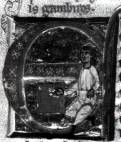
Guillem Magret
Encyclopedia

Floruit
Floruit , abbreviated fl. , is a Latin verb meaning "flourished", denoting the period of time during which something was active...
1195–1210) was a troubadour
Troubadour
A troubadour was a composer and performer of Old Occitan lyric poetry during the High Middle Ages . Since the word "troubadour" is etymologically masculine, a female troubadour is usually called a trobairitz....
and jongleur from the Viennois. He left behind eight poems, of which survive a sirventes
Sirventes
The sirventes or serventes is a genre of Occitan lyric poetry used by the troubadours. In early Catalan it became a sirventesch and was imported into that language in the fourteenth century, where it developed into a unique didactic/moralistic type...
and a canso
Canso (song)
The canso is a song style used by the troubadours. It consists of three parts. The first stanza is the exordium, where the composer explains his purpose. The main body of the song occurs in the following stanzas, and usually draw out a variety of relationships with the exordium. The canso can end...
with melodies.
According to his vida
Vida (Occitan literary form)
Vida is the usual term for a brief prose biography, written in Old Occitan, of a troubadour or trobairitz.The word vida means "life" in Occitan languages. In the chansonniers, the manuscript collections of medieval troubadour poetry, the works of a particular author are often accompanied by a...
, he was a gambler and publican who could not keep the money he earned but spent it away gambling and frequenting taverns, and so he was always ill-equipped for riding. In Maigret, pujat m’es el cap, a tenso with Guilhem Rainol d'Apt, he is despised by his debate partner as a joglar vielh, nesci, badoc: "an old, silly, stupid jongleur". Despite this, his biographer notes that he was well liked and honoured and his songs were "good".
Guillem travelled widely in Spain, sojourning at the courts of Peter II of Aragon
Peter II of Aragon
Peter II the Catholic was the King of Aragon and Count of Barcelona from 1196 to 1213.He was the son of Alfonso II of Aragon and Sancha of Castile...
and Alfonso IX of León
Alfonso IX of Leon
Alfonso IX was king of León and Galicia from the death of his father Ferdinand II in 1188 until his own death...
. Eventually he entered a hospital in Spain, in the land of "Lord Roiz Peire dels Gambiaros" (probably Pedro Ruiz de los Cameros), and there ended his life. Among the dates which can be established for Guillem's life are 1196, when he composed a song on the death of Alfonso II
Alfonso II of Aragon
Alfonso II or Alfons I ; Huesca, 1-25 March 1157 – 25 April 1196), called the Chaste or the Troubadour, was the King of Aragon and Count of Barcelona from 1164 until his death. He was the son of Ramon Berenguer IV of Barcelona and Petronilla of Aragon and the first King of Aragon who was...
and succession of Peter II in Aragon, and 1204, when he wrote a song to celebrate the November coronation of Peter by Pope Innocent III
Pope Innocent III
Pope Innocent III was Pope from 8 January 1198 until his death. His birth name was Lotario dei Conti di Segni, sometimes anglicised to Lothar of Segni....
in Rome
Rome
Rome is the capital of Italy and the country's largest and most populated city and comune, with over 2.7 million residents in . The city is located in the central-western portion of the Italian Peninsula, on the Tiber River within the Lazio region of Italy.Rome's history spans two and a half...
.
Guillem's music is rich, diverse, motivically-varied, and neumatically-textured. L'aigue puge contremont contains four unusual B
B (musical note)
B, also known as H, Si or Ti, is the seventh note of the solfège. It lies a chromatic semitone below C and is thus the enharmonic equivalent of C-flat....
–F
F (musical note)
F is a musical note, the fourth above C. It is also known as fa in fixed-do solfège.When calculated in equal temperament with a reference of A above middle C as 440 Hz, the frequency of Middle F is approximately 349.228 Hz. See pitch for a discussion of historical variations in...
leaps, which Guillem probably intended as a motive.
External links
- Maigret, pujat m’es el cap at Rialto.

